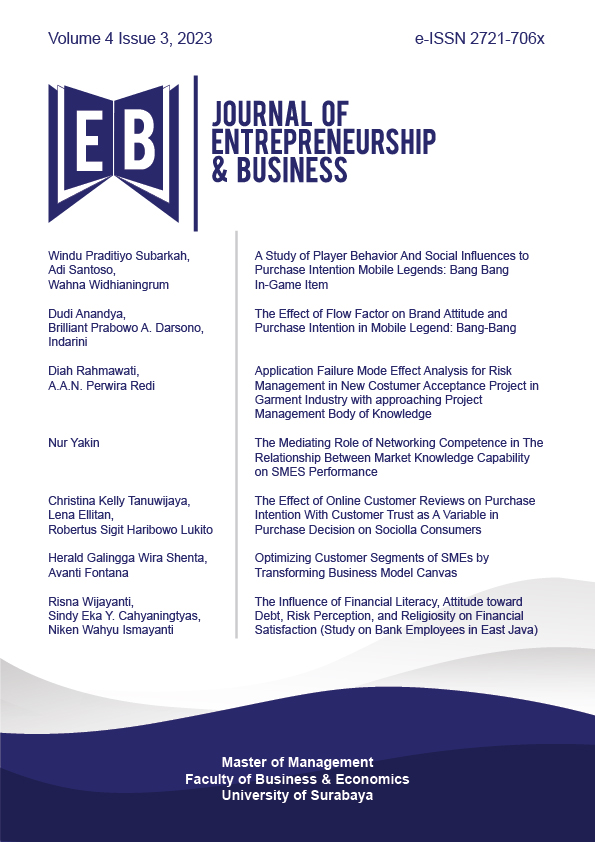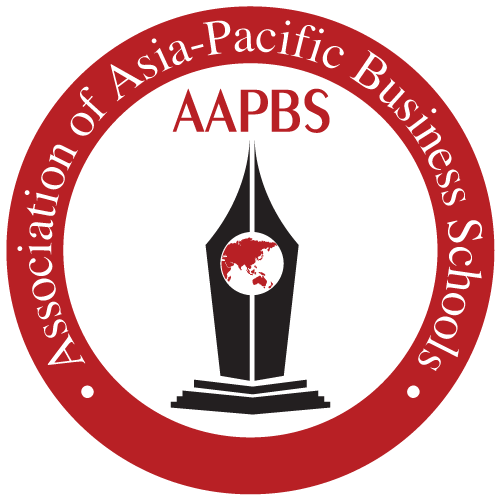The Effect of Flow Factor on Brand Attitude and Purchase Intention in Mobile Legend: Bang-Bang
 Abstract Views:
561 times
Abstract Views:
561 times
 PDF Downloads:
402 times
PDF Downloads:
402 times
Abstract
Purpose: This research aims to analyze the influence of flow antecedents, which can elicit brand attitudes and purchase intentions.
Method: By design, this research is included in causal research, which aims to examine causal relationships between variables. The scale used is an interval of 7 points. The target population is active mobile legends: Bang-bang players who play at least two games daily. The player must have purchased at least two items in the last six months and be 17 years old. Purchase decisions must be made with the player's considerations. The number of samples collected was 300 respondents. The sampling technique used is non-probability sampling with a purposive sampling method. The analysis technique used is structural equation modeling with two stages. The analysis technique used is structural equation modeling with two stages. Hypothesis testing uses a t-test with an alpha of 10%.
Result: Only skills that do not contribute to the formation of flow. This result is in line with previous research, so the role of skill as an antecedent needs to be studied further. Flow has been shown to shape brand attitudes and purchase intentions.
Downloads
References
Basudewa, G. (2023, April 14). Mobile legends Gelar Pesta mabar allstar MLBB. Mobile Legends Gelar Pesta Mabar ALLSTAR MLBB di Surabaya. https://www.skor.id/post/mobile-legends-gelar-pesta-mabar-allstar-mlbb-di-surabaya.
Bracken, C. C., & Skalski, P. (2009). Telepresence and Video Games: The Impact of Image Quality. PsychNology Journal, 7(1), 101–112. https://engagedscholarship.csuohio.edu/clcom_facpub/32/
Catalán, S., Martínez, E., & Wallace, E. (2019a). Analysing mobile advergaming effectiveness: the role of flow, game repetition and brand familiarity. Journal of Product and Brand Management, 28(4), 502–514. https://doi.org/10.1108/JPBM-07-2018-1929
Catalán, S., Martínez, E., & Wallace, E. (2019b). The role of flow for mobile advergaming effectiveness. Online Information Review, 43(7), 1228–1244. https://doi.org/10.1108/OIR-06-2018-0198
Csikszentmihalyi, M. (1975). Beyond boredom and anxiety. New Jersey: Jossey-Bass Publishers.
Csikszentmihalyi, M. (2009). Flow: The psychology of optimal experience. San Fransisco: Harper and Row.
Grossman, S. (2005). “Grand Theft Oreo”: The Constitutionality of Advergame Regulation. The Yale Law Journal, 115(1), 227–236. http://www.jstor.org/stable/25047601
Ham, C.-D., Yoon, G., & Nelson, M. R. (2016). The interplay of persuasion inference and flow experience in an entertaining food advergame. Journal of Consumer Behaviour, 15(3), 239–250. https://doi.org/10.1002/cb.1564
Hernandez, M. D. (2011). A model of flow experience as determinant of positive attitudes toward online advergames. Journal of Promotion Management, 17(3), 315–326. https://doi.org/10.1080/10496491.2011.596761
Hoffman, D. L., & Novak, T. P. (1996). Marketing in hypermedia computer-mediated environments: Conceptual Foundations. Journal of Marketing, 60(3), 50–68. https://doi.org/10.2307/1251841
Kemp, S. (2021, January 27). Digital 2021: The latest insights into the “state of Digital.” We Are Social UK. https://wearesocial.com/uk/blog/2021/01/digital-2021-the-latest-insights-into-the-state-of-digital/
Kim, T., & Biocca, F. (1997). Telepresence via television: Two dimensions of telepresence may have different connections to memory and persuasion. Journal of Computer-Mediated Communication, 3(2), 0–0. https://doi.org/10.1111/j.1083-6101.1997.tb00073.x
Lele, N. (2020, October 30). WCG 2023 MLBB Playoffs Stage: Schedule, teams, standing, format, where to watch. AFK Gaming. https://afkgaming.com/mobileesports/news/wcg-2023-mlbb-playoffs-stage-schedule-teams-standing-format-where-to-watch
Li, Z. (2023). Research on interactive interface design of Mobile Games. Proceedings of the 2nd International Conference on Culture, Design and Social Development (CDSD 2022), 283–289. https://doi.org/10.2991/978-2-38476-018-3_30
Liu, C. C. (2017). A model for exploring players flow experience in online games. Information Technology and People, 30(1), 139–162. https://doi.org/10.1108/ITP-06-2015-0139
Liu, C. C., & Chang, I. C. (2016). Model of online game addiction: The role of computer-mediated communication motives. Telematics and Informatics, 33(4), 904-915. https://doi.org/10.1016/j.tele.2016.02.002
Morris, M. H., Schindehutte, M., & LaForge, R. W. (2002). Entrepreneurial Marketing: A construct for Integrating Emerging Entrepreneurship and Marketing Perspectives. Journal of Marketing Theory and Practice, 10(4), 1–19. https://doi.org/10.1080/10696679.2002.11501922 .
Novak, T. P., Hoffman, D. L., & Yung, Y.-F. (2000). Measuring the customer experience in online environments: A structural modeling approach. Marketing Science, 19(1), 22–42. https://doi.org/10.1287/mksc.19.1.22.15184
Nugraha, M. (2022, November 25). Berapa Menit 1 match di mobile legends (ML)?. Esportsku. https://esportsku.com/berapa-menit-1-match-di-mobile-legends/
Pelet, J.-É., Ettis, S., & Cowart, K. (2017). Optimal experience of flow enhanced by telepresence: Evidence from social media use. Information & Management, 54(1), 115–128. https://doi.org/10.1016/j.im.2016.05.001
Peters, S., & Leshner, G. (2013). Get in the game: The effects of game-product congruity and product placement proximity on game players’ processing of brands embedded in Advergames. Journal of Advertising, 42(2–3), 113–130. https://doi.org/10.1080/00913367.2013.774584
Ping, J. W., Goh, K. Y., & Teo, H. H. (2010). Engaging Consumers with Advergames: an Experimental Evaluation of Interactivity, Relevancy and Expectancy. Proceedings of the International Conference on Information Systems, USA, Saint Louis, 12-15. http://dx.doi.org/10.17705/1jais.00366
Pratnyawan, A., & Rachmanta, R. D. (2021, August 12). Sebaran pemain mobile legends Indonesia, terbanyak di Pulau Ini. Sebaran Pemain Mobile Legends Indonesia, Terbanyak di Pulau Ini. https://www.suara.com/tekno/2021/08/12/142903/sebaran-pemain-mobile-legends-indonesia-terbanyak-di-pulau-ini?page=all
Redondo, I. (2012). The effectiveness of casual advergames on adolescents’ brand attitudes. European Journal of Marketing, 46(11/12), 1671–1688. https://doi.org/10.1108/03090561211260031
Rizaty, M. A. (2023, January 13). Pemain mobile legends Dunia capai 80,76 Juta Pada Desember 2022. Dataindonesia.id. https://dataindonesia.id/varia/detail/pemain-mobile-legends-dunia-capai-8076-juta-pada-desember-2022
Shneiderman, B. (1998). Designing the user interface: Strategies for effective human (3rd ed.). Boston, MA: Addison Wesley Longman, Inc.
Steuer, J. (1992). Defining virtual reality: Dimensions determining telepresence. Journal of Communication, 42(4), 73–93. https://doi.org/10.1111/j.1460-2466.1992.tb00812.x
Terlutter, R., & Capella, M. L. (2013). The gamification of advertising: Analysis and Research Directions of in-game advertising, advergames, and advertising in Social Network Games. Journal of Advertising, 42(2–3), 95–112. https://doi.org/10.1080/00913367.2013.774610
Tocci, M. (2023, January 13). Smartphone history - the first smartphone: Simpletexting. SMS Marketing & Text Marketing Services – Try It For Free. https://simpletexting.com/where-have-we-come-since-the-first-smartphone/
Vanwesenbeeck, I., Walrave, M., & Ponnet, K. (2016). Children and advergames: The role of product involvement, prior brand attitude, persuasion knowledge and game attitude in purchase intentions and changing attitudes. International Journal of Advertising, 36(4), 520–541. https://doi.org/10.1080/02650487.2016.1176637

This work is licensed under a Creative Commons Attribution 4.0 International License.
Articles published in Journal of Entrepreneurship & Business are licensed under a Creative Commons Attribution 4.0 International (CC BY) license. You are free to copy, transform, or redistribute articles for any lawful purpose in any medium, provided you give appropriate credit to the original author(s) and the journal, link to the license, and indicate if changes were made.
Authors submitting to this journal agree to make their work freely available under the CC BY 4.0 license, ensuring broad dissemination and reuse. The full license details can be accessed at https://creativecommons.org/licenses/by/4.0/.
This ensures that they receive the maximum dissemination because there are no barriers to access. This license allows readers to disseminate and reuse the paper, but always requires them to grant the authors and the first publication full credit.
While JEB upholds ethical publishing standards, the responsibility for ensuring originality and compliance with copyright regulations lies with the authors. The journal is not liable for any legal claims related to the content of published articles.
For further inquiries, please contact the editorial team.

 DOI:
DOI:











